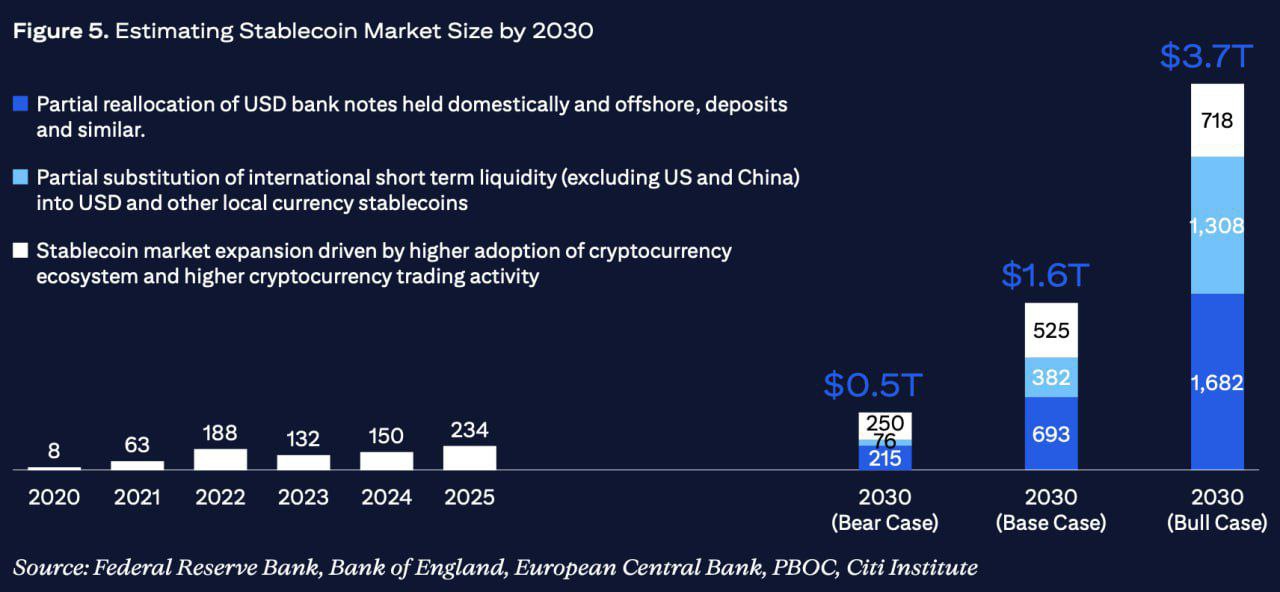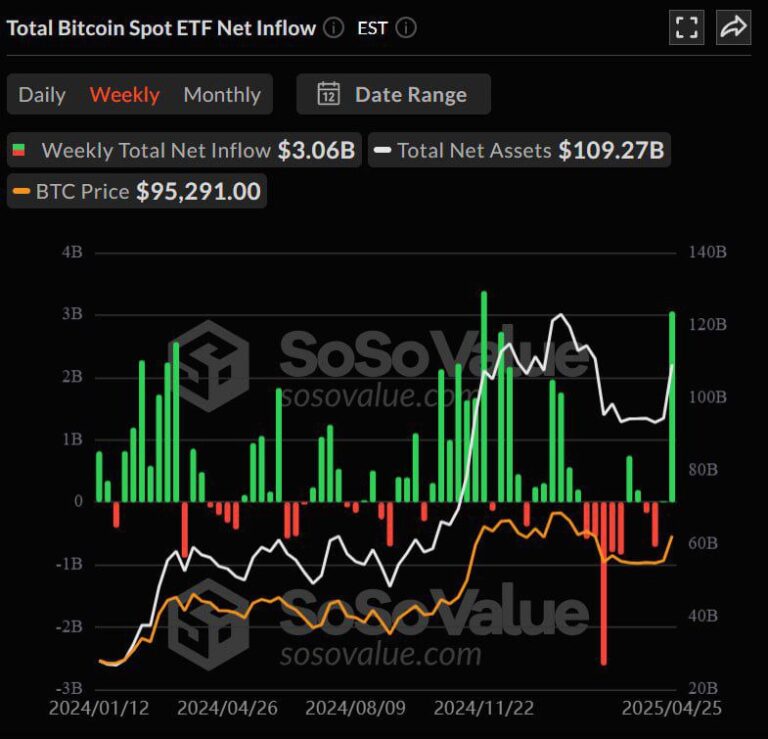The world of stablecoins is quickly evolving, and according to Citigroup’s latest report, the market could skyrocket to an astonishing $3.7 trillion by 2030. This could potentially reshape the global financial landscape, with stablecoins becoming a fundamental part of how we trade, transfer money, and manage liquidity. But what exactly could drive this meteoric rise, and what are the possible scenarios that could unfold in the coming years? Let’s dive in!

📊 Citigroup’s Three Scenarios for the Future of Stablecoins
In their recent report, Citigroup lays out three distinct scenarios for the future of stablecoins. These range from a bearish outlook to a bullish one, depending on factors like regulatory decisions, adoption rates, and market evolution. Here’s a quick breakdown:
🐻 Bear Case: $0.5 Trillion
In this scenario, stablecoins would remain relatively niche. Tight regulations, coupled with low adoption rates, would keep the market growth limited. The bear case suggests that stablecoins would still exist, but they wouldn’t capture widespread use, especially in global payments or mainstream adoption.
📊 Base Case: $1.6 Trillion
This is the moderate growth scenario, where stablecoins gradually gain traction, particularly for crypto trading and cross-border payments. In this case, we can expect a solid increase in their adoption, but not a full-scale revolution. The $1.6 trillion market size in this scenario suggests a steady progression toward wider use.
🚀 Bull Case: $3.7 Trillion
This is the most optimistic view, where stablecoins go mainstream. Imagine a future where stablecoins are used for global payments, including global settlements and bank liquidity optimization. As more businesses and individuals adopt stablecoins for cross-border transactions, crypto trading, and even everyday purchases, the stablecoin market could hit $3.7 trillion — positioning stablecoins as a cornerstone of global finance.
💰 Why Is the Stablecoin Market Growing So Fast?
1. Crypto Trading
Stablecoins have already proven their worth in the cryptocurrency market. They allow traders to quickly move in and out of positions without needing to convert to fiat currency, minimizing risk and transaction costs. This makes them an essential tool in the volatile world of digital asset trading.
2. Cross-Border Payments
One of the most exciting use cases for stablecoins is in cross-border payments. Traditional international money transfers can be slow, costly, and subject to exchange rate fluctuations. Stablecoins, on the other hand, allow for instant, low-cost, and borderless transactions, which is highly attractive to businesses and consumers alike.
3. Global Settlements
Another major use case is global settlements, particularly in industries like finance, real estate, and even supply chain management. Stablecoins can act as a bridge between fiat currencies, enabling quicker and cheaper settlements of transactions across borders.
4. Bank Liquidity Optimization
Stablecoins can also help banks optimize their liquidity management. By holding stablecoins, banks could benefit from greater efficiency in terms of capital reserves and interbank settlements, allowing them to improve their balance sheets and offer better services to their customers.
💵 The Role of USD-Backed Stablecoins
A crucial aspect of the stablecoin market is that the vast majority of stablecoins are expected to be USD-backed. According to Citigroup’s report, around 90% of all stablecoins will likely be tied to the U.S. dollar, which makes sense given the dollar’s dominance in global finance.
What does this mean for the broader financial system?
- Issuers Could Hold Over $1 Trillion in U.S. Treasuries: As the demand for stablecoins grows, issuers may need to hold large quantities of U.S. treasuries to back their coins. This could make stablecoin issuers key players in the treasury market, rivaling traditional banks in terms of holding U.S. debt.
- Institutional Adoption: The ability to hold and use stablecoins backed by the U.S. dollar may also appeal to institutions looking for an efficient and secure means of holding liquidity without relying on traditional banking systems.
🚀 Stablecoins: Not So Stable After All?
It’s ironic that stablecoins, by name, represent stability, but they are also a key growth sector in the crypto space. They are, in many ways, the bridge between the traditional financial system and the decentralized world of cryptocurrencies. As they grow, they may reshape not just how we trade and pay, but how financial institutions manage liquidity, handle global payments, and even settle transactions across borders.
With their wide-ranging applications and the potential for massive growth, stablecoins aren’t staying “stable” in the traditional sense—they’re growing rapidly and are primed to disrupt the financial landscape.
🚨 What Does This Mean for Investors?
If Citigroup’s projections hold true, investors could see a massive upside as the stablecoin market matures and expands. Here are a few key takeaways for investors:
- Diversify into Stablecoins: As stablecoins become more mainstream, they may represent an attractive investment opportunity, especially for those looking to capture the growth of blockchain technology and digital finance.
- Watch for Regulatory Changes: The pace of growth depends significantly on regulation. Keep an eye on how governments approach stablecoin legislation and what that could mean for adoption rates.
- Monitor Use Case Expansion: Watch for developments in how stablecoins are integrated into various sectors, such as global payments, bank liquidity, and crypto trading. The more widely adopted they become, the more valuable they will be.
🔮 Conclusion: The Future of Stablecoins is Bright (and Fast-Moving)
Stablecoins are no longer just a niche asset in the crypto space—they are poised to become a mainstream financial tool with vast use cases across the globe. With potential market growth from $0.5 trillion to $3.7 trillion by 2030, the future of stablecoins looks incredibly promising.
As they become an essential part of the financial ecosystem, stablecoins could unlock new possibilities for crypto traders, businesses, banks, and individuals looking for efficient ways to transfer money and manage liquidity. Whether you’re a trader, an institutional investor, or just someone curious about the future of money, now is the time to pay attention to the rapidly evolving stablecoin market.








